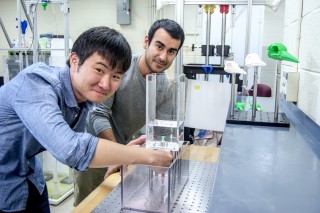Oct 15 2015
Dolphins and whales may attract a lot of attention when they leap dramatically out of the water. But aquatic animals thousands of times smaller are accomplished jumpers, too.
 Students in the Jung lab at Virginia tech set up an experiment to model jumping plankton. Credit:Virginia Tech
Students in the Jung lab at Virginia tech set up an experiment to model jumping plankton. Credit:Virginia Tech
Their acrobatics often go unnoticed, but understanding them could help improve engineering processes, like oil refining and wastewater treatment, that rely on controlling the interaction of small particles with air-water interfaces.
Sunghwan Jung, an associate professor of biomedical engineering and mechanics in Virginia Tech’s College of Engineering, has released a new study focused on the jumping behavior of copepods, small teardrop-shaped plankton near the bottom of the aquatic food chain that can sometimes vault out of the water to escape predators.
The paper, published in the journal Interface, showed that the copepod’s velocity is the primary factor determining whether it can break the surface or not, and suggests that these copepods may be the smallest animals capable of leaping out of the water into the air.
For a moving body to break the air-water interface, it must have enough inertia to overcome not only gravity but also the water’s surface tension — the attractive force between molecules that makes the surface elastic. Surface tension is what allows liquids to form droplets and keeps lightweight bugs like water striders from sinking.
For larger animals like dolphins and fish, the surface tension is negligible compared to their own mass, so gravity is the primary consideration.
But for tiny animals, like plankton, “There’s a huge energy cost to deform the surface,” Jung explained. Animals below a certain size will simply stretch the surface and bounce back instead of breaking through.
For water, this critical length is around three millimeters — about the size of a copepod. (This is also about the maximum size of a raindrop: larger droplets would split as gravity overcame the surface tension.)
But only certain species of copepods can actually jump out of the water. What makes the difference?
To answer that question, Jung and his coauthors simulated leaping plankton by setting up a spring — harvested from a retractable pen — at the base of a tank of water, and launched spherical beads towards the surface. A high-speed video camera tracked the beads’ movement, allowing the researchers to monitor which ones broke the surface.
The experiments showed that the particle’s velocity is the most important factor: the faster a particle flew towards the surface, the more likely it was to break through. Other parameters, like the angle of contact and the particle’s surface characteristics, didn’t matter as much.
The researchers also recorded high-speed video of jumping and non-jumping copepods, which supported the results obtained with their model system.
Only one of the four copepod species the team studied was observed breaking the water’s surface. These copepods, around three millimeters long, had to achieve impact speeds of about one meter per second — a pace that would correspond to a human swimming at more than 600 meters per second.
Smaller species swimming nearly as fast simply deformed the water’s surface and bounced back; so did larger species moving more slowly.
These results suggest that the jumping copepods in Jung’s study may represent the smallest animal that can actually leap out of the water: because velocity is the main factor, animals smaller than three millimeters would have to swim faster than one meter per second to overcome water’s surface tension. But because the amount of power an organism can generate is proportional to the square of its size, it’s very unlikely that smaller animals could reach such high speeds.
641252.SupplementaryMovie
Jung said that this finding that could eventually inform the design of tiny, jumping aquatic robots, answering the question “What is the smallest robot you can create that can jump out of the water?”
The study, which was supported by the National Science Foundation and by the Institute for Critical Technology and Applied Science at Virginia Tech, lays the foundation for research into separation processes in fields like mining and wastewater treatment, which use the air-water interfaces created by small bubbles to remove particulates from liquids. Jung plans to explore these applications in future studies.
Jung’s research often uses biological systems, like drinking cats and dogs, and swimming worms, as inspiration for problems in fluid dynamics. He and his students routinely design custom model systems, using springs, weights, and 3D-printed components to mimic animals’ interaction with fluids.
“Biological systems are hard to control — we cannot ask copepods to jump at a lower speed — and have complex components, like legs and mouths,” Jung explained. “So we try to model them with a simpler system.”